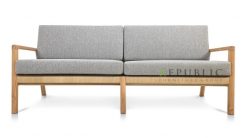Basically, batik can made by stamping and printing. In addition to the various manufacturing processes, batik has various motifs. Research conducted noted that there were at least 5,849 Indonesian batik motifs spread from Aceh to Papua. The diversity of motifs and the strong philosophical values that accompany this batik have also made the United Nations Educational, Scientific, and Cultural Organization (UNESCO) officially designate batik as a Humanitarian Heritage for Oral and Intangible Culture on October 2, 2009.
Here are some Indonesian Batik motifs:
Betawi Batik
Betawi batik is not as popular as Yogyakarta, Solo, or Pekalongan batik. However, the rich variety of Betawi batik motifs cannot be ignored. In terms of color, Betawi batik usually uses bright colors, such as green, red, and blue. Then, for patterns, Betawi batik is mostly inspired by cultural values found in society. Betawi batik has ancient motifs which include the nusa coconut motif, the ciliwung motif, the rasamala motif, the salakanegara motif, the bamboo shoot motif, and the ondel-ondel motif. Unfortunately, now Betawi batik motifs are hard to find. The only ancient Betawi batik motif that still survives is the ondel-ondel motif. In terms of meaning, the ondel-ondel motif symbolizes rejecting reinforcements. In addition to ancient motifs, Betawi batik also presents variety of modern motifs, including Monas motifs, coconut flowers, and even TransJakarta motifs.
Yogyakarta Batik
Yogyakarta is one of the most popular batik-producing areas in Indonesia. In addition, the area which is dubbed the city of culture also has a variety of meaningful batik motifs and usually each motif is only used at certain moments. Some of the familiar Yogyakarta batik motifs include the ceplok motif, the truntum motif, the machete motif, the nitik motif, and the kawung motif. Take the kawung motif for example. In this motif, four elliptical circles are drawn around a small circle as the center. The elliptical circle is arranged lengthwise according to alternating slanted diagonal lines to the left or right. The inspiration for this motif comes from the palm fruit which is halved. Not just an image, the motif turns out to have a deep meaning, namely showing the four wind directions with their respective symbols. On the east side there is a sunrise which symbolizes the source of life, in the north there is a mountain which means the abode of the gods, west is the direction of sunset which symbolizes the descent of luck, and in the south there is a zenith which means the peak of everything. Long ago, the kawung motif was often worn by sentana dalem (people who have family relations with the king) in the Ngayogyakarta Hadiningrat Sultanate. Along with the times, this batik is widely used by the wider community.
Batik Solo
Not far from Yogyakarta, there is Solo city which also has a long history of batik. Although many people think that the batik motifs and patterns of these two regions are the same, it turns out that this assumption is not entirely true. In terms of style, Solo batik tends to use brown or dark colors as a background. Of course this is different from Yogyakarta batik which uses white as the basic color. The second difference is in the motive. Even so, they both maintain the standard design of the palace, there are fundamental differences. For example, in the parang motif, Yogyakarta batik depicts parang from the top right to the bottom left. In Solo batik, the parang motif is depicted from top left to bottom right. Solo batik motifs are not only limited to the parang motif, there are many motifs with various meanings, such as the sidomukti motif which utilizes welfare, the truntum motif which means love grows back, the satrio manah motif which is usually used for proposals, and other motifs.
Semarang Batik
Shifting to the north of Central Java, there is Semarang city which also has a variety of batik motifs. In terms of style and color, Semarang batik has a big difference compared to Yogyakarta and Solo batik. Semarang batik tends to use bright colors and less dense patterns. In terms of motifs, Semarang batik has blend character of coastal batik with the mixed culture of the Chinese community. Typical coastal motifs include patterns of flora and fauna of peacocks, butterflies, storks, cempaka, roses, and blekok birds. Not only that, Semarang batik also has a variety of contemporary Semarang icon motifs, such as Lawang Sewu, Tugu Muda, and tamarind.
Cirebon Batik
Talking about coastal batik, it seems that Semarang batik is not only the most popular. Because, there is Cirebon batik which is famous for its megamendung motif, pincuk motif, golden train motif, and slope motif. Just like Semarang batik, Cirebon batik also uses bright colors as a background and most of the motifs are inspired by the surrounding natural conditions. One of the things that distinguishes Cirebon batik from other regions batik in Indonesia is the process of making it, especially the coloring part. The batik artists in Cirebon call the process of coloring their batik as treatment. This process is done by placing the cloth in a tool called a treatment tool. This tool is shaped like a scale that is used by shaking it from side to side so that the dye absorbs completely.
The charm of batik is not only limited to the five areas that have been mentioned. However, these five regions can represent how rich and diverse types of batik are in Indonesia.
–sh





